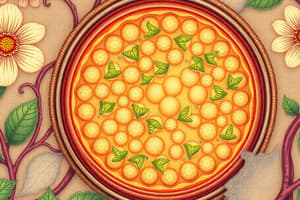Podcast
Questions and Answers
Which component of a plant cell is responsible for photosynthesis?
Which component of a plant cell is responsible for photosynthesis?
- Nucleus
- Mitochondria
- Chloroplasts (correct)
- Endoplasmic Reticulum
What is the primary function of the vacuole in a plant cell?
What is the primary function of the vacuole in a plant cell?
- Generating ATP
- Storing nutrients and waste products (correct)
- Controlling cell activities
- Synthesizing proteins
Which type of plant cell is known for providing flexible support?
Which type of plant cell is known for providing flexible support?
- Parenchyma Cells
- Collenchyma Cells (correct)
- Xylem Cells
- Sclerenchyma Cells
What role does the cell wall play in plant cells?
What role does the cell wall play in plant cells?
What is the main role of mitochondria in plant cells?
What is the main role of mitochondria in plant cells?
Which of the following cells is primarily involved in the transport of water and minerals?
Which of the following cells is primarily involved in the transport of water and minerals?
What is one of the main functions of the Golgi apparatus in plant cells?
What is one of the main functions of the Golgi apparatus in plant cells?
What process involves the conversion of light energy into glucose in plant cells?
What process involves the conversion of light energy into glucose in plant cells?
Which of the following statements accurately describes chloroplasts?
Which of the following statements accurately describes chloroplasts?
Parenchyma cells have thick cell walls and provide rigid support.
Parenchyma cells have thick cell walls and provide rigid support.
What is the function of the large central vacuole in plant cells?
What is the function of the large central vacuole in plant cells?
The rigid outer layer of a plant cell that provides structure is called the ______.
The rigid outer layer of a plant cell that provides structure is called the ______.
Match the following types of plant cells with their functions:
Match the following types of plant cells with their functions:
Which part of the plant cell regulates the movement of substances in and out?
Which part of the plant cell regulates the movement of substances in and out?
Sclerenchyma cells are typically living cells that provide flexible support.
Sclerenchyma cells are typically living cells that provide flexible support.
What primary pigment is found in chloroplasts and is essential for photosynthesis?
What primary pigment is found in chloroplasts and is essential for photosynthesis?
Flashcards are hidden until you start studying
Study Notes
Plant Cells
-
Definition: Basic structural and functional units of plants, responsible for various physiological processes.
-
Key Components:
- Cell Wall:
- Rigid outer layer made of cellulose.
- Provides structure and protection.
- Plasma Membrane:
- Semi-permeable barrier that controls the movement of substances in and out of the cell.
- Cytoplasm:
- Gel-like substance where cell organelles are suspended.
- Nucleus:
- Contains genetic material (DNA).
- Controls cell activities and reproduction.
- Chloroplasts:
- Site of photosynthesis.
- Contain chlorophyll, which captures sunlight.
- Vacuole:
- Large central vacuole stores water, nutrients, and waste products.
- Helps maintain turgor pressure, contributing to plant rigidity.
- Mitochondria:
- Powerhouse of the cell; generates ATP through cellular respiration.
- Endoplasmic Reticulum (ER):
- Network of membranes involved in protein and lipid synthesis.
- Rough ER has ribosomes; Smooth ER does not.
- Golgi Apparatus:
- Modifies, sorts, and packages proteins and lipids for secretion or use within the cell.
- Cell Wall:
-
Types of Plant Cells:
- Parenchyma Cells:
- Involved in storage, photosynthesis, and tissue repair.
- Collenchyma Cells:
- Provide flexible support, especially in young stems and leaves.
- Sclerenchyma Cells:
- Provide rigid support; have thick lignified cell walls.
- Xylem Cells:
- Transport water and minerals from roots to other parts of the plant.
- Phloem Cells:
- Transport sugars and nutrients produced via photosynthesis.
- Parenchyma Cells:
-
Functions:
- Photosynthesis: Conversion of light energy into chemical energy stored in glucose.
- Growth and Repair: Cell division and differentiation allow for growth and healing.
- Storage: Cells store starch, oils, and other substances for energy and structural purposes.
- Transport: Movement of water, minerals, and nutrients is crucial for overall plant health.
-
Differences from Animal Cells:
- Presence of a cell wall and chloroplasts in plant cells.
- Large central vacuole vs. smaller vacuoles in animal cells.
- Typically rectangular shape in plant cells vs. varied shapes in animal cells.
Overview of Plant Cells
- Basic building blocks of plants, vital for physiological functions and overall health.
Key Components
- Cell Wall:
- Composed primarily of cellulose, providing structure and protection.
- Plasma Membrane:
- Semi-permeable layer regulating substance movement in and out of the cell.
- Cytoplasm:
- Gel-like substance where organelles are suspended, supporting cellular activities.
- Nucleus:
- Houses DNA, governing cell activities and reproduction processes.
- Chloroplasts:
- Site for photosynthesis; chlorophyll within captures solar energy.
- Vacuole:
- Large central structure for storing water, nutrients, and waste, contributing to turgor pressure for plant rigidity.
- Mitochondria:
- Main energy producers of the cell, generating ATP through cellular respiration.
- Endoplasmic Reticulum (ER):
- Membrane network involved in protein and lipid synthesis; Rough ER has ribosomes, while Smooth ER lacks them.
- Golgi Apparatus:
- Modifies, sorts, and packages proteins and lipids for distribution or use within the cell.
Types of Plant Cells
- Parenchyma Cells:
- Function in storage, photosynthesis, and repair of tissues.
- Collenchyma Cells:
- Provide flexible support in young stems and leaves.
- Sclerenchyma Cells:
- Offer rigid support with thick, lignified walls.
- Xylem Cells:
- Specialized for transporting water and minerals from roots throughout the plant.
- Phloem Cells:
- Responsible for the transport of sugars and nutrients produced during photosynthesis.
Functions of Plant Cells
- Photosynthesis:
- Process of converting light energy into chemical energy stored in glucose.
- Growth and Repair:
- Cell division and differentiation enable new growth and healing of tissues.
- Storage:
- Cells accumulate starch, oils, and other substances for energy and structural support.
- Transport:
- Essential movement of water, minerals, and nutrients for maintaining plant vitality.
Differences from Animal Cells
- Plant cells have a cell wall and chloroplasts, while animal cells do not.
- Plant cells typically contain a large central vacuole, contrasting with smaller vacuoles in animal cells.
- The overall shape of plant cells is generally rectangular compared to the varied shapes of animal cells.
Overview of Plant Cells
- Plant cells are eukaryotic and form the fundamental tissues of plants.
- They possess unique characteristics that differentiate them from animal cells.
Key Features of Plant Cells
-
Cell Wall
- Composed of cellulose, providing rigidity and protection.
- Maintains the structural shape of the cell.
-
Chloroplasts
- Organelles that contain chlorophyll, essential for photosynthesis.
- Responsible for converting sunlight into energy and giving plants their green hue.
-
Large Central Vacuole
- Major organelle for storing water, nutrients, and waste.
- Maintains turgor pressure to keep the plant firm and upright.
-
Plasma Membrane
- Semi-permeable barrier that controls substance movement into and out of the cell.
-
Cytoplasm
- Viscous fluid that houses organelles and is the site for metabolic activities.
-
Nucleus
- Houses genetic material (DNA) and regulates cellular processes and functions.
Types of Plant Cells
-
Parenchyma Cells
- Involved in photosynthesis, nutrient storage, and repairing tissues.
- Characterized by thin cell walls.
-
Collenchyma Cells
- Offer support while allowing flexibility through unevenly thickened walls.
-
Sclerenchyma Cells
- Provide rigid support due to their thick, lignified walls and are typically dead at maturity.
-
Xylem Cells
- Responsible for transporting water and minerals from roots to leaves while providing structural support.
-
Phloem Cells
- Facilitate the transport of sugars and nutrients across the plant, including sieve elements and companion cells.
Functions of Plant Cells
- Photosynthesis: Converts solar energy into chemical energy for growth.
- Storage: Stores essential substances like starches and sugars.
- Transport: Moves water, nutrients, and food within the plant.
- Support: Maintains structural integrity and strength of the plant body.
Importance of Plant Cells
- Critical for the growth and development of plants.
- Play a vital role in ecosystems by producing oxygen and food sources.
- Enhance biodiversity and contribute to the overall health of the planet.
Studying That Suits You
Use AI to generate personalized quizzes and flashcards to suit your learning preferences.





